Mixing students, butterflies and flowers together in Helliwell is magical
By Chris Junck, Taylor’s Checkerspot Butterfly Recovery Project and GOERT, with contributions from Pascale Archibald, Stephanie Govier and Neil Wilson
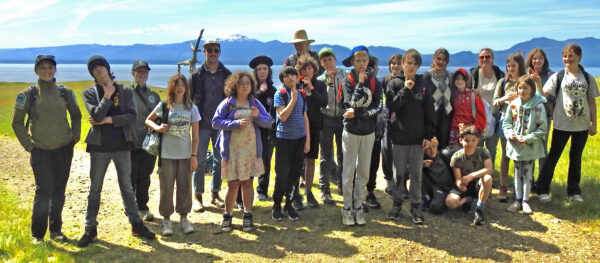
Hornby Island Community School field trip to Helliwell Park, May 2024. Photo by Bill Hamilton.
Take 19 excited students near the end of the school term in May; place them in a meadow of delicate wildflowers in Helliwell Provincial Park; add endangered Taylor’s checkerspot and propertius duskywing butterflies and other insects; mix well and let them simmer for two hours. Does this seem like a recipe for an ecological disaster or potential chaos? Apparently not when they are well-prepared Hornby Island Community School students on a field trip to Helliwell that was carefully planned and managed. The students were guided by their teacher, Garret Holt, BC Parks conservation specialist Stephanie Govier, and butterfly technician Pascale Archibald. Hornby Island Natural History Centre stewards Bill Hamilton and Neil Wilson, Community School staffer Jala Klone, and park ranger Sam Rae Harris were on hand to provide additional information and field trip support.
Stephanie Govier and Pascale Archibald outlined the coastal bluff meadow habitat restoration efforts in Helliwell Park over the last several years. Neil Wilson spoke about the contributions of students from the school during that time, which involved the planting of thousands of native butterfly host and food plants, which had been propagated by stewards of the Hornby Island Natural History Centre. Taylor’s checkerspot lifecycle stages were reviewed before students were handed laminated information sheets, surveys, pencils and clipboards and then sent to observe insects. Quite a few species were caught with nets by adults and placed in containers to study for a moment before being safely released.
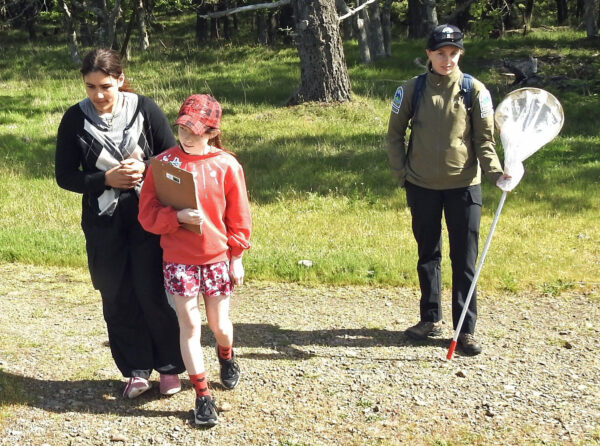
Students with information sheets and field survey forms. Photo by Bill Hamilton.
“It impressed me how careful everyone was to not injure the bugs and by how much care was taken to stay on the trails to avoid trampling,” said Neil Wilson.
In the catch were several species of bees, flies, beetles and butterflies, including a propertius duskywing and a Taylor’s checkerspot butterfly – one of many spotted by the team of citizen scientists. The two-hour lesson also focused on meadow plants important for pollinators.
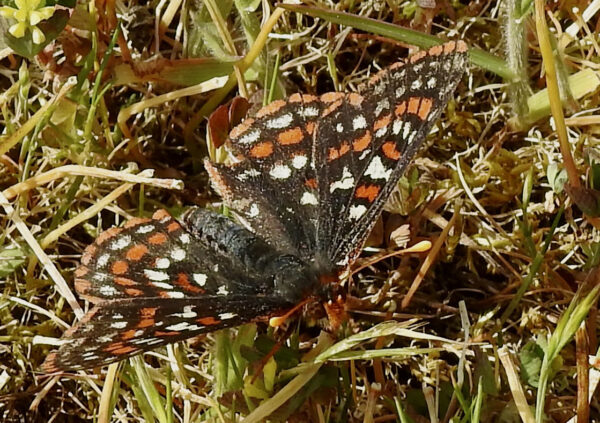
Several Taylor’s checkerspot butterflies and other insects were observed.
Photo by Bill Hamilton.
The field trip was part of ongoing efforts to increase awareness about the importance of pollinator insects. It also highlighted the collaborative work by BC Parks and the Taylor’s Checkerspot Butterfly Recovery Project Team to re-establish a viable population of the endangered species in Helliwell Park.
Taylor’s checkerspot butterflies vanished from Hornby Island in the mid-1990s. After several years of habitat restoration work and annual releases of Taylor’s checkerspot butterfly caterpillars in Helliwell Park, the project team finally received encouraging news this spring. In March, butterfly technicians Pascale Archibald and Kihan Yoon-Henderson found more than 230 Taylor’s checkerspot larvae that successfully overwintered in the park to continue their lifecycle.
At the end of March, the team released another 100 Taylor’s checkerspot butterfly caterpillars in Helliwell Park near St. John’s Point, and 340 larvae for the first time on Flora Islet. The caterpillars were raised at the Greater Vancouver Zoo by Wildlife Preservation Canada staff Andrea Gielens.

More than 130 Taylor’s checkerspot butterflies were found during surveys in May. Photo by Pascale Archibald.
Pascale Archibald conducted follow-up surveys of adult Taylor’s checkerspot butterflies and their offspring in Helliwell Park. More than 130 individual butterflies were observed on 14 survey days between May 9th and 29th. She also found 88 clusters of larvae between June 8th and 13th. “There are definitely more out there though as I didn’t manage to search the entire meadow area,” said Archibald.
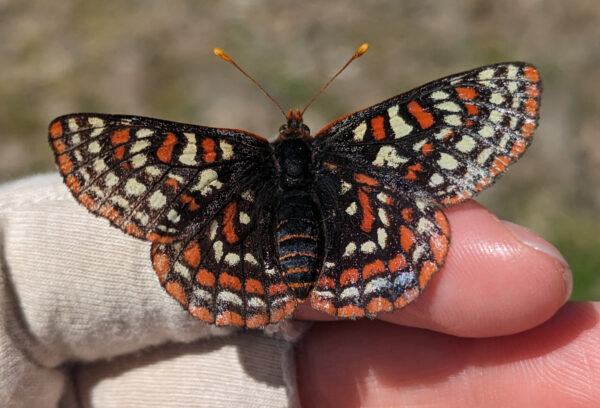
Butterflies were marked to avoid double counting. Photo by Pascale Archibald.
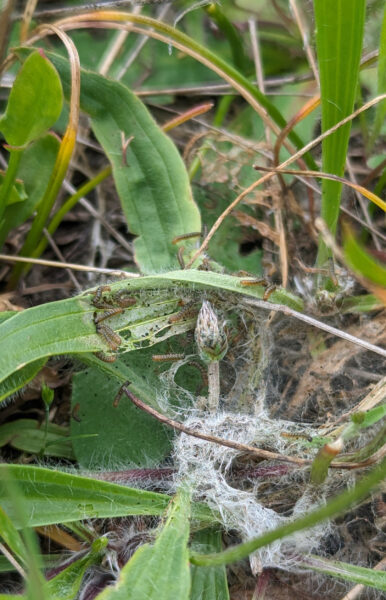
In June, Pascale also located 88 webs containing hundreds of Taylor’s checkerspot larvae. It’s proof that the butterflies are producing offspring, which is a hopeful sign that the reintroduction project is succeeding. Photo by Pascale Archibald.
While these are very hopeful signs for Taylor’s checkerspot butterfly recovery in Helliwell Park, their future is not assured. The caterpillars are tiny, delicate and vulnerable. Trampling by park visitors, dogs and bicycles are a key threat to the larvae and the plants they need to survive.
Helliwell’s visitors can increase the caterpillars’ chance of survival by adhering to park rules. “Dogs must be on a leash according to provincial park regulations, and bikes aren’t allowed in this park,” said Stephanie Govier. Please walk carefully and watch out for caterpillars. Stay on the trails that are delineated by ropes and restoration area signs. If you visit Flora Islet, stay on the shore, and avoid the fragile meadows. This will reduce the possibility of stepping on a caterpillar or their host plants.
Don’t move or pick up Taylor’s checkerspots. Instead, report sightings to Taylors.Checkerspot@gov.bc.ca, or by using the free iNaturalist app (www.inaturalist.org). It is an easy-to-use species identification tool that enables citizen scientists to record and contribute important species data for projects around the globe.
BC Parks and the project team thank the Cowichan Tribes, Halalt, Homalco, K’ómoks, Lake Cowichan, Lyackson, Penelakut, Qualicum, Snaw’Naw’As, Stz’uminus, Tla’amin, We Wai Kai, and We Wai Kum First Nations for allowing us to restore ecosystems in their traditional territories. Several local volunteers from Conservancy Hornby Island, the Hornby Island Natural History Centre, the Hornby Island Provincial Parks Committee, and others also contributed to the success of this project.
The recovery project has benefited from funding and in-kind contributions from the BC Parks Licence Plate Program, the Habitat Conservation Trust Foundation, the Environment Canada Habitat Stewardship Fund, and the B.C. Ministry of Environment and Climate Change Strategy (Ecosystems Branch), and others.
The Taylor’s Checkerspot Butterfly Recovery Project Team includes biological consultants and representatives from the B.C. Ministry of Water, Land and Resource Stewardship, B.C. Ministry of Environment and Climate Change Strategy, BC Parks, Denman Conservancy Association, Garry Oak Ecosystems Recovery Team, Greater Vancouver Zoo, Mosaic Forest Management, Wildlife Preservation Canada, and others.